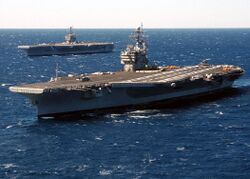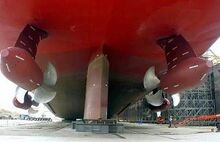Lehendakari Aguirre Class
| Lehendakari Aguirre Class Aircraft Carrier | |
 Lehendakari Aguirre Class Aircraft Carrier | |
| Career | File:800px-Flag of Euskadi.png |
|---|---|
| Nationality: | Euskadi |
| Operated by: | Eusko Itsas Gudarostea |
| Builder: | Built by:Newport News Shipbuilding Refitted by:Euskalduna Ontziolak SA |
| Ordered: | March 1996 |
| Commissioned: | December 1996 |
| Status: | In Service |
| General characteristics | |
| Displacement: | 87,000 tons |
| Length: | 330 m |
| Beam: | 87 m |
| Draft: | 12 m |
| Power: | 210 MW |
| Propulsion: | NAtech Hybrid Multi-Gas Power Plant with four pods |
| Speed: | 33 knots |
| Maximum speed: | 45 knots |
| Range: | 19,000 nautical miles at 33 knots |
| Complement: | Ships company 3,000 Air wing: 1,940 |
| Armament: | Sensors 1 x TERMA C-Flex Combat Management System 1 x TERMA ATM Air Traffic Management 1 x TERMA C-Fire Control System 2 x Saab EOS 500 Weapons Control Radar 2 x TERMA SCANTER 6000 Surveillance Radar 1 x TERMA Hull Inspector Sensor 1 x TERMA DD90 Diver Detection System Electronic warfare 1 x TERMA SME-200 Tactical EMS / ELINT 1 x TERMA NLWS Naval Laser Warning System Decoys 2 x TERMA DL-12T decoy launcher 2 x TERMA Loki torpedo countermeasure Armament 3 x 8-cell Ezpata Vertical Launching System 2 x Long range Acoustic Device 4 x Phalanx_CIWS |
| Aircraft carried: | 70+ 2010 Typical Aircraft wing: 40 x JAS39 Sea Gripen 2 x C-2 Greyhound 2 x Saab 2000 AEW&C 2 x Sea King HAR4 Search and Rescue 6 x AS532 Cougar ASUW / ASW 12 UAVs |
The Lehendakari Aguirre Class aircraft carrier is the first aircraft carrier class in service under Euskadi flag and the only "supercarrier" in service. She is the former US Navy Kitty Hawk class USS America.
Background
In early 1996, and in one of his last controversial decisions, Lehendakari Arbizu signed an agreement with the United States to immediately purchase the aircraft carrier USS America. In addition, both governments signed the option of purchasing another aircraft of its class in 2000 that never was exercised.
At the time the decision sowed much controversy since large sections of society, but also of the Navy, questioned the appropriateness of the purchase assuming a supercarrier was not the most appropriate for the needs of the Eusko Itsas Gudarostea.
A few months later, Lehendakari Arbizu was forced to resign and although the new government tried to stop the operation first payments were already made and the aircraft carrier was commissioned in December 1996.
In the period 2000-2005 under the socialist government the ship was about to be dismantled but after EAJ regained power in 2005,a Life Extension Program was ordered so that the ship will be operating at least until 2016.
2005 Refit and Life Extension Program
Design
Once the Extend Life Program was aproved, technicians began working on the redesign of the ship.
The guidelines were as follows:
- Reforming and strengthening of the hull
- Changes in the flight deck to accommodate the new aircraft and new automated systems
- Installing a new power plant more modern and efficient, adapted to the new requirements of power
- A completely new installation of all the ship's electronic systems
- Upgrading weapons systems
Hull
New hull modifications include a new propeller design, a new bulbous bow design that provides more buoyancy to the forward end of the ship and improves hull efficiency, curved flight deck edges to reduce radar signature, a new underwater hull-coating system, deck covering modernized to reduce ship weight by 100 tons, low Solar Absorptive and Anti-Stain Paint, and a redesigned hangar bay that has less clutter.
Flight deck
Changes to the flight deck are the most visible of the differences between the Kitty Hawk and Lehendakari Aguirre classes. Several sections have been altered from the layout of the Kitty Hawk class flight deck to improve aircraft handling, storage, and flow. Lehendakari Aguirre Class have no catapult-specific restrictions on launching aircraft, but still retains 4 catapults, 2 bow and 2 waist and the number of aircraft lifts from hangar deck to flight deck level is reduced from 4 to 3. The design changes to the flight deck are instrumental in the maximization of sortie generation.
The route of weapons to the aircraft stops on the flight deck has been replanned to accommodate higher re-arming rates, and in turn higher potential sortie rates.
Another major change is the creation of a deck space for a centralized re-arming and re-fueling location. This reduces the number of times that an aircraft will have to be moved after landing before it can be launched again. Fewer aircraft movements require, in turn, fewer deck hands to accomplish them, reducing the size of the ship's crew. On Lehendakari Aguirre Class carriers the time that it takes to launch a plane after it has landed is defined by the time necessary to re-arm and re-fuel. To minimize this time, ordnance will be moved by robotic devices from storage areas to the centralized re-arming location via re-located weapons elevators. The new path that ordnance follows does not cross any areas of aircraft movement, thereby reducing traffic problems in the hangars and on the flight deck. The launching system has been completly redefined and the old steam catapults habe been replaced by Electromagnetic Aircraft Launch System (EMALS) developed by General Atomics for the Everetty Gerald R. Ford-class aircraftcarriers. This system allows to launch aircraft from carriers using a linear motor drive instead of steam pistons used in conventional aircraft catapults. This technology reduces stress on airframes because they can be accelerated more gradually to takeoff speed than steam-powered catapults. EMALS also uses less fresh water, reducing the need for energy-intensive desalination.
Power generation & propulsion
The power plant of the ship has been completely redesigned to suit the needs and requirements of the RUN and the new systems and elements of the ship. IEIA chose to equip the ship with a clean fuel cell propulsion system developed by the company NAtech .
The power plant of the ship was designed taking into account the current needs of energy for propulsion and other systems on board, so it was possible to assume an increase in power required if new equipment or systems were installed in the future.
For the propulsion of the ship NAtech has developed a solution combining 4 NAtech Statpower System power plants of 40 MW each with 8 NAsoft ST energy servers with 8MW power each. Aditional NAsoft ST energy servers provide the electricity needed for the ship military and support systems.
The propulsion system is fully electrical with four AZIPOD s (ABB azimut thrusters) mounted externally to the main hull. The electricity for the motors is supplied by the power system. The diagram below shows the propulsion architecture.
Electronic systems
One of the main design premises was the need to mount common electronic systems in order to full integration with other Armed Forces systems and satellite net.
Sensors
- 1 x TERMA C-Flex Combat Management System
- 1 x TERMA ATM Air Traffic Management
- 1 x TERMA C-Fire Fire Control System
- 2 x Saab EOS 500 Weapons Control Radar
- 2 x TERMA SCANTER 6000 Surveillance Radar
- 1 x TERMA Hull Inspector Sensor
- 1 x TERMA DD90 Diver Detection System
Electronic warfare
Decoys
Armament
The Lehendakari Aguirre Class uses three main weapon systems.The weapons system of the ships are:
- 2 x 8 cell Ezpata Vertical Missile Launchers
- 2 x Long Range Acoustic Device
- 4 x Phalanx_CIWS
Air wing
The ship are able to carry more than 70 aircrafts. The 2010 Typical Aircraft wing is formed by:
- 40 x JAS39 Sea Gripen
- 2 x C-2 Greyhound
- 2 x Saab 2000 AEW&C
- 2 x Sea King HAR4 Search and Rescue
- 6 x AS532 Cougar ASUW / ASW
- 12 UAVs
List of ships
| # | Name | Ordered | Commissioned |
| C-11 | EEO Lehendakari Aguirre | March 1996 | December 1996 |


